Dogs
Dogs
Large Dogs
Definition
What are “large dogs”?
Under the current legislation, dogs weighing 20kg or more are classified as “large dogs”.
Some examples of breeds which usually weigh more than 20kg when mature include:
Afghan Hound, Alaskan Malamute, Bernese Mountain Dog, Chow Chow, Collie, Doberman Pinscher, English Bull Terrier, German Shepherd, Golden Retriever, Great Dane, Greyhound, Husky, Labrador, Mastiff, Old English Sheepdog, Rhodesian Ridgeback, Rottweiler, St. Bernard.
Other breeds, and many mongrels and crossbreeds may also weigh over 20kg.
Proper Control
When a large dog is in a public place, the following control measures must be applied:
- When you enter a public place with a large dog, you must observe the duty of care and be fully focused while controlling your dog.
- Large dogs shall be securely held on a leash of not more than 2 metres in length by a person at all times; OR
- Large dogs shall be securely tied to a fixed object on a leash of not more than 1.5 metres in length in a manner that does not pose a danger to the public and animal safety, and welfare of the dog.
- In country parks, large dogs may be exercised without a leash, provided they are still under effective control.
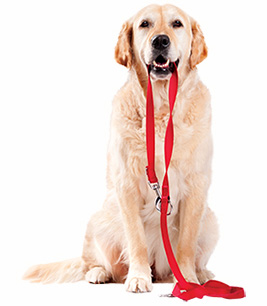
Suggestions for the control of “large dogs”
- Training – If a large dog displays aggressive behaviour, it could cause serious harm to the injured person. Therefore, you should start training your dog from an early age to ensure that you can control it properly and that it responds to your commands. You can find out more about training your dog here.
- If you get your dog as a puppy, socialisation is also very important – you can find out more about this here.
- Ensure that any person walking your dog has enough physical strength to control it - If your dog is being taken care of by someone else (for example, a domestic helper), you should ensure that the person walking the dog has enough physical strength to hold the dog on a leash securely and can control and manage the dog properly. In addition, you should ensure that you have enough physical strength to hold your large dog on a leash securely and can control and manage the dog properly while you bring your dog out for a walk. Quite a number of cases where the large dogs injured other people or animals were due to the fact that the person walking the dog did not have enough strength to control the dog and the person could not stop the dog from misbehaving.
- Exercising your dog – Choose a suitable place with fewer people to exercise your dog to prevent it from causing nuisance to other people.
- Avoiding accidents and injuries – If your dog has a tendency to show aggressive behaviour, in addition to the above measures, consider using a muzzle on your dog (but be careful when using a muzzle in hot weather).
- Please dispose of your dog’s droppings properly.
- Please keep your dog on a leash once you leave a country park.
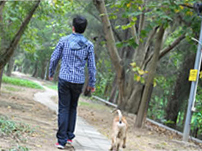
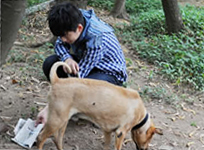
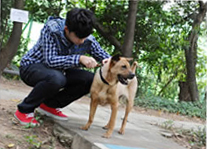
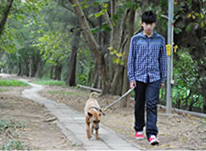
Summary
Pets are for life. Keeping any dog, especially a large dog, is a big responsibility which needs careful consideration beforehand. Before keeping a large dog, make sure you consider carefully whether you have the ability to properly look after and control it for the rest of its life. Also bear in mind the likely size and strength of the dog when it is fully grown.
Exemption Exam
Under Hong Kong law, “large dogs” must be securely held on a leash not longer than 2 metres in public places. However, if you believe you have a well-trained large dog and would like to exercise your large dog off leash, you can participate in the exemption examination for large dogs.
AFCD will hold examination sessions every year.
Please note that participation in the examination is voluntary. Owners of large dogs who are content to exercise their dogs on leash in public places and outdoor areas need not apply to sit for this examination.
Please see below for examination content.
Protocol
The examination comprises of two parts, both of which must be completed successfully. During the examination, the owner must not use any tools that would interfere with the performance of the dog being tested, for example, prong collars, adjustable dog collars (choke collars) and any tools that prevent the dog from barking such as bark terminators and bark terminating collars, etc.
Test 1- Assessment of temperament
A veterinary assessment of temperament will be conducted according to the protocol established by the Australian RSPCA (please click). The assessment will be done by AFCD’s Veterinary Officer in the absence of the dog owner.
In addition to the assessment criteria as listed in the protocol, while the tests are being conducted, the dog should not demonstrate signs of overt aggression towards other dogs or humans. The below criterion will be added to the protocol to assess the temperament of the dog:
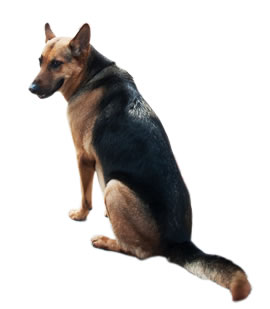
Bring the dog being tested to another dog which is separated by wired fencing to assess its reaction [Both dogs must be on leash]:-
- It shows sociable behaviours
- It shows little reaction
- It growls, barks, rushes towards the other dog or becomes overly aggressive
Dogs with one or more "unacceptable" results or more than four "borderline" results in test 1 will be considered to have failed the test and will not be permitted to proceed to test 2.
Test 2 - Assessment of control
This test will be conducted in a circuit approximately 160 metres in length. The owner is required to walk around the circuit once with his dog unleashed. At all times owner must control his/her dog without touching it. The circuit will be marked by flags placed 10 metres apart. Please note that the circuit has recently been revised. (see attached circuit diagram in PDF file) [Download Acrobat Reader for viewing the document] or PNG file.
This test contains four elements, all of which must be completed successfully to obtain a pass.
-
Element 1 - walking with dog off leash
The dog must remain within 10 metres of the owner at all times and within the confines of the markers during the walk around the circuit. The owner is free to decide the distance he allows the dog to move away from him up to the 10 metre limit. [Note: the "10 metre limit" does not apply during the conduct of the other three elements of the test described below]
-
Element 2 - encounter with a stranger
At one point in the circuit a stranger will walk towards the dog and owner. When the stranger and the owner meet, the dog must sit, stay or drop beside the owner. The stranger will stop, talk to the owner and offer him/her an object. The dog must show no signs of aggression towards the stranger.
-
Element 3 - recall dog
At the next point in the circuit the owner and dog must separate by a distance of at least 10 metres and then the owner recalls the dog. The owner can do this by sending the dog off and recalling it or, if the dog is not trained to be sent off, by getting the dog to sit and stay while the owner walks at least 10 metres away and then recalls the dog.The owner should wait for the Veterinary Officer's signal before recalling the dog. Whilst the dog is being commanded to stay, there will be distraction and moving objects, such as a person riding a bicycle, playing football or walking with small pups, etc. outside the circuit.
-
Element 4 - encounter with a stranger walking a dog on leash
At the next point in the circuit, a stranger walking a friendly, leashed dog will walk towards the dog and owner. When the stranger and the owner meet, the dog must sit, stay or drop beside the owner. The stranger will stop, talk to the owner and offer him/her an object. The dog must show no signs of overt aggression towards the stranger or the other dog.
Retests
No retake of examination on the same day will be offered. Any dog that fails the examination may retake it at future examination sessions. There is no restriction on the number of attempts.
Dog that passes the Exemption Examination
Sample of the medal:
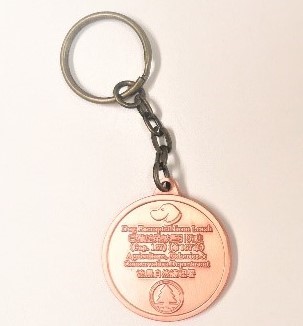
Schedule
Exemption Examination for Large Dogs is scheduled as below:
| Date | Venue | Remarks |
|---|---|---|
| 28 March 2026 (Sat) |
Yuen Long Ping Pak Lane Park
|
Registration quota of every examination is 40 dogs and available on a first come first served basis. (On or before 16 January 2026) |
Application details
Please submit the following documents by fax, mail, or in person to the New Territories South Animal Management Centre of AFCD:
- Completed application form (Please download the application form here)
- Copy of valid dog licence
- Copy of valid vaccination certificate of major infectious diseases (i.e. Canine distemper virus, Canine parvovirus and Canine contagious hepatitis virus)
- Proof of dog body weight
Guidance Notes
- Confirmation of Dog Body Weight
All applications are required to attach with a certificate to prove that the dog is equal to or over 20kg. All applicants could choose to provide the proof in one of the below 3 ways:
- Any written proof from a Private Veterinary Clinic which could show the AVID / ISO microchip number and the body weight (>=20kg) of the dog (The written proof includes medical records that can display the required information; we will also accept medical records issued within 6 months prior to the application date for Large Dog Exemption Examination (LDEE)).
- The applicant can bring the dog into one of the AMCs to weigh the dog and our staff will issue a Confirmation of Dog Body Weight form.
- If the applicant is not able to provide the above-mentioned proof 1 or 2, they can do it on site at the venue of the LDEE. However, AFCD could reject the dog taking the examination if the dog's weight is less than 20kg on the date of the exam.
- To avoid possible conflict with ongoing legal proceedings, any application involving a dog currently under investigation in a biter case will be declined until the case has been concluded.
- Even if a dog has passed the Large Dog Exemption Examination, if the keeper of the dog contravenes any condition specified in Cap. 167F section 1(1), whether or not the person is prosecuted under section 17(3) of the Dogs and Cats Ordinance in relation to that contravention, this Department reserves the right to consider cessation of exemption for the dog concerned.
Please contact the following Animal Management Centre for details:
![]() : NT South Animal Management Centre, 11 To Shek Path, Sha Tin, N.T.
: NT South Animal Management Centre, 11 To Shek Path, Sha Tin, N.T.
![]() : 2609 4642
: 2609 4642
![]() : 2694 7649
: 2694 7649
Legislation
Applicable Legislation:
The control of large dogs is governed by the Dangerous Dogs Regulation (Cap. 167D) Section 9. Anyone contravening this section is liable to a fine of $25,000 and imprisonment for 3 months.